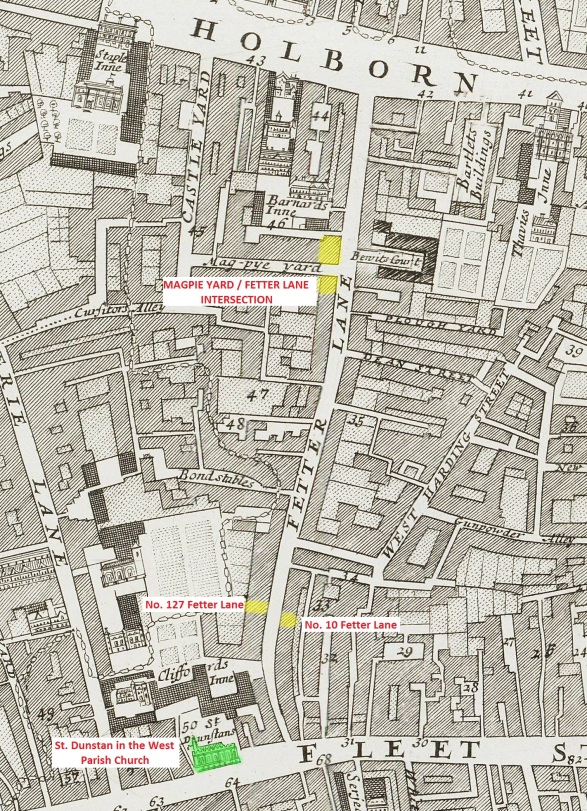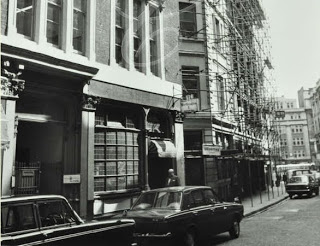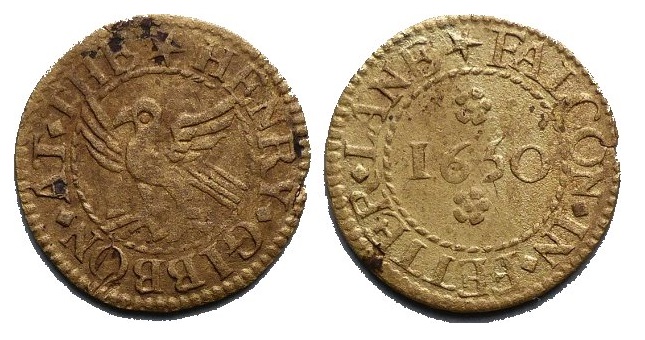The above brass farthing token measures 15.8 mm and weighs 0.99 grams. It was issued in 1650 by Henry Gibbon a tradesman of Fetter Lane in the Farringdon Ward Without district of London. Its design may be formally described as follows;
Obverse: (mullet) HENRY. GIBBON . AT .THE , around a twisted wire inner border, within the depiction of a bird of prey facing left with its wings raised.
Reverse: (mullet) FALCON . IN . FETTER . LANE , around a twisted wire inner border. Within the date 1650 with a rosette above and below.
In the mid-17th century, as now, Fetter Lane linked Holborn in the north with Fleet Street in the south. During this period the lane was home to a considerable number of token issuers with thirty eight separate examples so far recorded from a wide variety of different tradesmen. These include tavern keepers, a grocer, a candle maker, grain dealer and a cheesemonger(1)(2). Interestingly a review of these tokens shows that five of them were issued by tradesmen operating at or adjacent to premises bearing the trade sign of the falcon. A summary listing of these is given below;
- Henry Gibbon at the Falcon in Fetter Lane; 1650; farthing
- J. B. at the Falcon in Fetter Lane; farthing
- G.L. & P.L. at the Falcon in Magpie Yard, Fetter Lane; farthing
- Robert Langborne & J. Langborne at the Falcon in Fetter Lane; farthing
- Robert Langley & J. Langley at the Falcon in Fetter Lane; farthing
Given that British trademen’s token were issued over an extended period in the third quarter of the 17th century (i.e. 1648 to 1672) it is possible that one or more of the above were issued by successive traders operating from the same business premises. In addition it is arguable that at least two of the above tokens were issued by the same tradesman. By the standards of 17th century phonetic spelling the issuers “Langborne” and “Langley” could easily be the same individual. The likelihood of this is even more probable given that in both cases the token issuer wife’s Christian name initial is “J”. Given such observations it is possible that there could have been fewer than five premises in Fetter Lane during the third quarter of the 17th century displaying the sign of the falcon.
As a trade sign the falcon is first recorded in London in 1423. Its appears to have found common but not necessarily exclusive use as a brew house and tavern sign(3) .Bryant Lillywhite’s Survey of London Trade Signs(4) records four separate examples of this sign between 1650 and 1966. Correctly or not he attributes all of them to taverns, ale houses or inns;
- The Falcon Tavern in Fetter Lane – 1650 to c.1715
- The Falcon at No. 127 Fetter Lane – 1826 to c.1860s
- The Falcon Hotel in Fetter Lane – 1866
- The Falcon Tavern at No. 10 Fetter Lane – 1739(5) to 1966 (Note 1)
A Golden Falcon is also recorded in Fetter Lane in 1710(6). It is uncertain if this is an additional example to those listed above or just a name variant of one of them.

Fetter Lane c.1720 – Showing known locations where there were businesses displaying the sign of the Falcon plus the parish church of St. Dunstan in the West.
A review of the Hearth Tax returns for London and Middlesex for Lady Day 1666 has failed to identify a Henry Gibbon or Gibbons in Fetter Lane or any other part of the city(7). This may imply that by 1666 he had moved out of his business premises (and possibly the capital) or had died. Analysis of a range of different contemporary documents, including several London Livery Company apprenticeship records, have further failed to identify him with any certainty.
An entry for a Henry Gibbon is contained in Boyd’s Inhabitants of London data base (8). While we have no means of confirming if this record is for the token issuer of 1650 it certainly offers a possibility. Boyd’s record lists Henry Gibbon as one of nine children born to Simon and Jane Gibbon. Simon Gibbon was a goldsmith and parishioner of St. Mathew’s, Friday Street, London. Boyd gives Henry’s birth year as 1611 which would have made him 39 in 1650 (i.e. the year of the above token’s issue). A further set of contemporary references to a Henry Gibbon (alternatively spelt Gibbons and Gibbens) has been found in the Westminster Rate Books and the Minutes Books of the Governors of Bridewell and Bethlem hospitals. In the current writer’s option these are less likely to be references to Henry Gibbon the token issuer of 1650 (see Note 2).
Of all the contemporary records so far viewed in the search for Henry Gibbons two stand out as offering the highest degrees of potential. The first of these is the Will (dated 16th May 1653 and proven in July 1653) of Henry Gibbons a stationer living in the parish of St. Dunstan in the West(9). This parish included much of the lower part of Fetter Lane and its surroundings. The second record is potentially even more significant. It takes the form of a burial entry in the registers of the parish church of St. Dunstan in the West. This church, located on the north side of Fleet Street at a point just west of its intersection with Fetter Lane.
14th January 1652/3 – Mr. Henry Gibbons, chandler, buried, out of Fetter Lane.
While the individuals in these last two records share a common name and home parish their stated professions and different dates of death confirm that they are two separate individuals.
In summary the limited available historic evidence points to Henry Gibbon(s) being a candle maker who lived and worked at premises at or by the sign of the Falcon in the lower part of Fetter Lane and who died within three years of him issuing his own farthing trades tokens.
Notes:
1) During 1796 the Falcon Tavern at No.10 Fetter Lane played host to meetings of the celebrated London Corresponding Society (10). The premises survived the intense German bombing of the early 1940s and remained until the 1970s when the area was re-developed. Today the tavern’s former location is marked by the southern part and service entrance of the Slug and Lattice Bar on the south-eastern side of Fetter Lane.

The Falcon Tavern at No.10 Fetter Lane as it appeared in the 1970s (viewed looking south-east into Fleet Street).
2) While thought less likely to relate to Henry Gibbon the token issuer of 1650 two additional sets of contemporary references to a man of similar name have earlier been noted. These almost certainly refer to two separate individuals. A summary of these references are given below for completeness.
a) A Henry Gibbon or Gibbons is variously recorded in the Governors’ Court Minute Books as a patient in Bridewell Hospital between the period 1618 and 1647.
b) A Henry Gibbon/Gibbons or Gibbens is variously recorded in the Westminster Rate Books (11) between 1646 and 1674. It is unclear if these entries refer to a single or multiple individuals. A summary of entries by year and address are listed below;
1646 – The Strand, St. Martin-in-the-Fields.
1646 – Bedford Street (Landside), St. Martin-in-the-Fields.
1647 – The Street, St. Martin-in-the-Fields.
1648 – Little Church Street, St. Martin-in-the-Fields.
1649, 1651 & 1654 – The Street, St. Martin-in-the-Fields.
1654 – Bedford Street (Landside), St. Martin-in-the-Fields.
1655 – The Street, St. Martin-in-the-Fields.
1655 & 1658 – Bedford Street (Landside), St. Martin-in-the-Fields.
1673 – St. Margaret’s, Westminster.
1674 – Swan Yard, St. Margaret’s, Westminster.
References:
- Williamson. G.C. – Trade Tokens Issued in the Seventeenth Century in England, Wales and Ireland by Corporations, Merchants, Tradesmen, Etc. – A New and Revised Edition of William Boyne’s Work. – Volume 2. (London, 1967).
- Dickinson, M.J. – Seventeenth Century Tokens of the British Isles and their Values. (London, 2004).
- Lillywhite, B. – London Signs: A Reference Book of London Signs from Earliest Times to about the Mid Nineteenth Century. (London, 1972).
- Ibid.
- Newman, I. – London Corresponding Society Meeting Places – Exploring the 1790s Alehouse (www.1790salehouse.com; February 2012).
- Ibid.
- Davies, M.; Ferguson, C.; Harding, V.; Parkinson, E. & Wareham, A. – London and Middlesex Hearth Tax. The British Record Society. Hearth Tax Series Volume IX, Part II. (London, 2014).
- Boyd, P. – Inhabitants of London. A genealogical Index held by the Society of Genealogists, London.
- PROB 11/230/110 – Will of Henry Gibbons (16th May 1653), National Archives, London.
- Ibid [5].
- Westminster Rate Books 1634-1900 Transcription – Entries for Humphrey Vaughan for 1656, 1663, 1666, 1672 and 1705.



